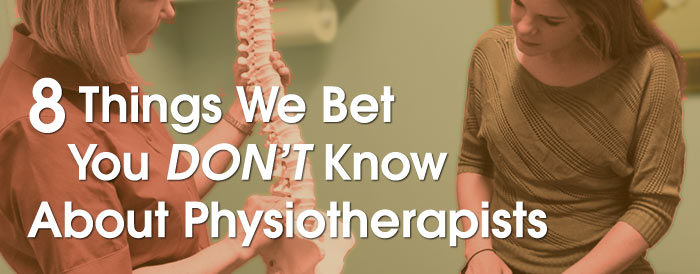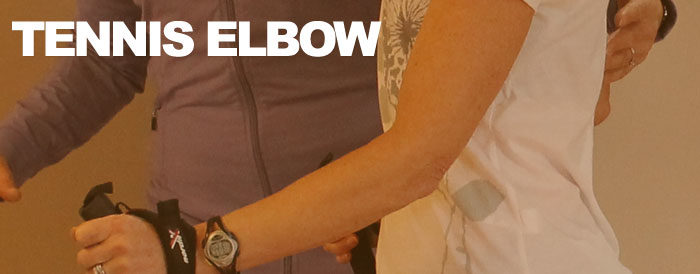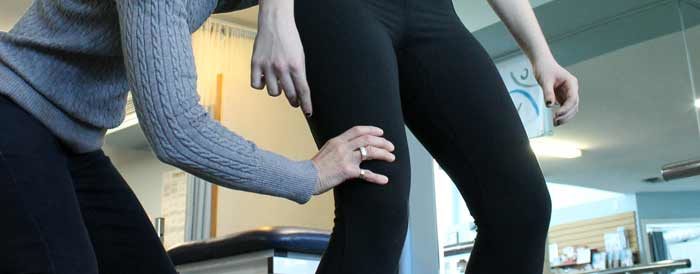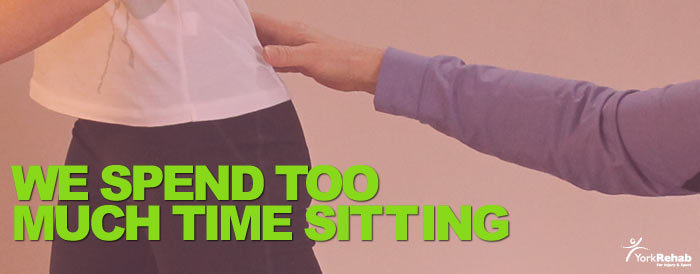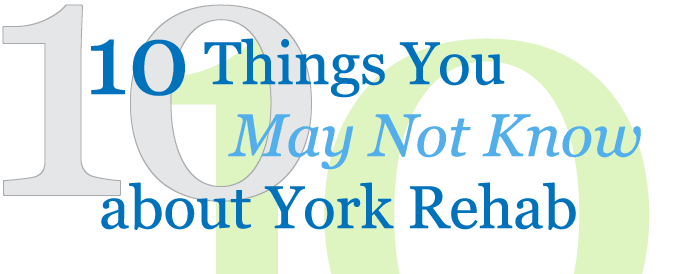Injury & Recovery
8 Things We Bet You Don’t Know About Physiotherapists
You have probably heard about physiotherapy and have a general idea about what it is. But how much do you know about physiotherapists? Here are some things you probably don’t know about us:
- Recovery is our focus, not maintenance. Our goal is to help you feel better as quickly as possible and get you on the road to recovery while minimizing the number of return visits.
- You don’t need a doctor’s referral to see a Physiotherapist – if you think you need to see a Physio, give a clinic near you a call and discuss your needs. If you have health insurance, be sure to check and see what your insurer requires and covers since most physiotherapy is not covered by OHIP.
- We are university educated healthcare professionals. In addition to completing an undergraduate degree, along with a Master’s Degree in Physiotherapy, we must pass a comprehensive oral and written exam that we only have three chances to pass – three unsuccessful attempts leads to choosing another career. After successfully acquiring our degree and completing the exam, then and only then can we legally use the title Physiotherapist. Be aware that some injury care providers offer physiotherapy but it’s important to note that someone who says they do physiotherapy is not necessarily a Physiotherapist.
- We know body mechanics really well! By observing some of your basic movements we can determine what exercises you need to do to become better at your sport, reduce injury and even recommend activities you can begin if you’d like to become more active and find your stride in a regular activity or sport.
- We are not just about helping you recover from aches and pains. We are also an integral part of recovery after heart surgery, we provide treatment for lung conditions (like chronic bronchitis, asthma, emphysema or pneumonia) and we can help manage neurological conditions (i.e. Parkinson’s and MS).
- Babies are our patients too! When babies are born with minor muscular issues such as torticollis, we can help. Torticollis is a condition of the neck that happens when a major muscle called the sternocleidomastoid becomes shortened or contracted. This shortening causes the baby’s head to be fixed in a tilted position. By gently stretching the affected muscle, educating parents about proper head bolster positioning and teaching at-home stretches and strengthening exercises, we can help speed up recovery and minimize long-term complications. Pediatric Physiotherapists can also assess your child to ensure he/she is meeting their physical developmental milestones.
- We can help new moms overcome diastasis recti, bladder incontinence, low back pain and pelvic floor disability. Many new moms feel that these postnatal concerns are something that they will have to live with or are normal. But there is nothing normal about incontinence or consistent pain, and a physiotherapist can help retrain and strengthen these weak muscles.
- Acupuncture can be part of a physiotherapy treatment plan as it helps promote healing, reduce or relieve pain and improve function of the affected area of the body. The practice of acupuncture is learned through a specialized training program completed after earning a Physiotherapy designation.
I have Tennis Elbow? But I don’t play tennis!
What is Tennis Elbow? Medically known as lateral epicondylitis, it happens when your elbow tendons are strained or injured. These are the muscles that allow you to grip or twist, and are vulnerable to injury from repetitive motions of the wrist and arm.
Does this sound familiar? You are coming off the 18th hole at the golf course and as you reach for a club, you feel soreness in your left arm that extends up towards your neck. It’s your first round of the season so you don’t think much of it. But when you are getting ready for bed that evening, the soreness is more noticeable and has started to throb.
Or perhaps you spent that bright sunny Newmarket Saturday, re-staining the deck and painting the fence. The work is done and you’re ready to relax and enjoy dinner but feel sharp pain as you cut into your food. You take a pain reliever to ease the pain and help you get some rest. By the morning the pain is back along with soreness.
Days after your golf game or painting project you also continue to experience pain. When tasks that involve gripping, turning, or bending your wrist, simple things like opening a door or drinking from your coffee mug, make you wince. These are signs that you may have Tennis Elbow.
Tennis Elbow can develop from:
- Unaccustomed or repetitive activity like painting, hammering, gardening or carrying something heavy
- Excessive or constant gripping, turning or wringing motions like those performed by carpenters, plumbers, butchers and even cashiers
- Poor forearm muscle strength or tight muscles
- Repetitive movements that involve bending the wrist in a turning or backwards motion
Tennis Elbow can become a chronic injury if left untreated. If you think you might have Tennis Elbow, consider coming to York Rehab for an assessment by one of our physiotherapists. Working with a physiotherapist is an effective way to reduce the pain associated with Tennis Elbow, restore normal range of motion and find the root of the problem.
To get you on the road to recovery, our physiotherapists will create an individualized treatment plan based on your level of physical activity and lifestyle. The treatment plan could include: manual therapy, acupuncture, ultrasound, laser treatments, muscle stretches, massage and strengthening.
While Tennis Elbow is not life threatening, it can be life altering – affecting how you enjoy the activities that you love. Tennis Elbow is pain you do not have to live with! Visit our Newmarket physiotherapy clinic, we can help.
5 Quick Ways to Avoid Knee Pain
Knees are the most commonly injured joints in the body and for some simply walking can cause pain. Knee pain is often caused when the muscles of the leg are weak – quadriceps (front of thigh), hamstrings (back of thigh) and gluteal (buttocks).
Weakness in any of these muscles can lead to an imbalance in your knees. But when the muscles of your leg are strong, it keeps the knee in alignment and relieves some of the pressure in your knees. The best way to strengthen your knees is to develop these muscles.
Even if you are already experiencing knee pain, it is not too late to strengthen your legs.Performing resistance exercises will strengthen the weak muscles, ease your knee pain and decrease your chances of sustaining a knee injury. Resistance bands are an inexpensive and beginner friendly way to incorporate resistance into your exercises and develop muscles.
5 Exercises To Strengthen Legs and Keep Knee Pain Away:
- Side Steps: Tie the ends of a resistance band together to form a loop. Place the loop around your legs, secured below your knees. Bend your knees slightly and place your feet hip-width apart. Take a step to the right until the band provides some resistance.
Bring your left foot in towards your right foot, returning to the starting stance. Continue sidestepping to your right for 15 steps and then take 15 steps to the left. - Monster Walk: Loop the resistance band around your legs and secure below your knees. Bend your knees slightly and place your feet hip-width apart. Step forward and to the side at a 45 degree angle with your right foot. Remember to keep the bend in your knees. Now step forward and to the left at a 45 degree angle. Continue alternating steps to the right and left on a 45 degree angle for 30 steps.
- Hamstring Curls: Holding on to the back of a chair or counter, place your feet shoulder width apart. Loop the resistance band around your ankles and without moving your hips, bend your right knee and bring your heel up towards your buttocks. Hold for 5 seconds and then slowly lower your leg. Complete 15 repetitions and then switch legs.
- Lateral Leg Raise: Lay on your right side with your legs extended out and stacked one atop the other. Loop the resistance band around your ankles. Slowly lift your left leg up, until you meet resistance in the band. Lower your leg and return to the starting position. Complete 15 repetitions and then switch sides.
- Bridge: Lie on your back with feet flat on the floor, bending your knees to 90 degrees. Loop the resistance band around your legs, just above your knees. Raise your hips until your shoulders, hips and knees align. Hold for 5 seconds, lower hips slowly to floor. Do 15 repetitions.
Remember to keep the movements slow and controlled. Think about contracting the muscles.
Complete 3 sets of each exercise and rest as needed between sets. Aim to do the exercises two to three times a week to help strengthen your knees.
These exercises are meant to help strengthen your legs and should not hurt. If you experience any pain in the muscles or joints when exercising, you should stop that exercise.
Looking for a customized exercise plan or guidance on how to perform these exercises? You can book an appointment with one of the physiotherapists at York Rehab’s Newmarket Physio Clinic. They can assess your injury, offer a treatment plan for rehabilitation and share advice on injury prevention.
Too Much Sitting!
The habit of “how long we sit at our desk” is becoming a trending topic. Studies are linking prolonged periods of sitting to an increase in the risk of hazardous health issues like heart disease, obesity, diabetes, and even cancer. A more disconcerting note is that we may not be able to counter the risks by complimenting the habit with regular exercise.
It may be a little early to tell whether the research provides a valid link. However, regardless of the medical research, paying some attention to the data has merit. It’s obvious we currently exist within a very sedentary culture, and it’s continuing to get worse. The fact that we sit at a desk for 7 or 8 hours a day may not be the root cause but it’s certainly compounding what some might call a sitting epidemic. Let’s remove science from the equation and simply look at some basic facts in today’s culture:
- We work much longer hours, which makes coming home to plop down on the couch so much more enticing.
- As housing prices continue to rise, it pushes us further outside the city (where our jobs usually are) to purchase a home which increases the commute.
- We live in a world of screens (tablet, TV, mobile device, computer) which require us to be still while using them.
- With the advent of video streaming services like Netflix, binge watching is now a hobby.
- Socializing these days is more likely to be done via a “tweet”, “like”, “share”, “pin”, “video”, “pic” or “post” instead of going out to connect with a friend face to face.
- Also, with the average household having more screens than people the likelihood of ending up in front of a screen is high.
Therefore, it is no wonder sitting has become a topic of concern. However, the problem is deeper than the time at your work desk – it’s linked to the culture of today. Like generations before us, a work day usually required people to be stuck at a desk for 7 – 8 hours (a fact likely not to change anytime soon), but that didn’t necessarily translate into the health issues now tied to “sitting at a desk”. It is the other factors in addition to the workday sitting (a necessary evil) that’s creating the problem.
It would make sense to pay some attention to your daily sitting habits (both mandatory and leisurely) and figure out how to reduce any patterns of extended sitting. If you can’t change your work situation maybe you can tweak it as well as revise some of your leisurely habits to reduce the amount of sitting. Some ideas to consider:
- Avoid bringing lunch back to your desk – take a walk (not a drive) and eat somewhere else (even if you end up sitting there).
- Try having a “walking meeting” with colleagues – it’s said that movement which increases blood flow can improve thinking and creativity.
- Explore whether you can leave work early and continue working remotely – yes, you’ll still sit but you’ll break up the prolonged sitting in one spot.
- Get rid of your cable tv package – the more entertainment options you have, the more you watch.
- Take “binge watching” out of your vocabulary – pace yourself and watch those 10 episodes over 10 days instead 10 hours straight.
- If none of your friends are active – it’s time to find some new ones!
- Bring back the “let’s go for a walk” activity.
Make a commitment to turn off, plug out and thumb down when you can and let’s take back our health – and we don’t need any more research to tell us we should! For more ideas on things to do, visit our Activity Guide.

